At a modern LAN cafe in downtown Manhattan, a teenager with floppy brown hair zones out to a Kingdom Come: Deliverance Twitch stream. He’s lounging with a Mountain Dew and an empty cup of coffee. Behind him, 30 PCs glow with light from rounds of League of Legends and PlayerUnknown’s Battlegrounds.
Waypoint Cafe (New York, NY)
Waypoint Cafe, which opened in New York’s Lower East Side last September, charges $US5 ($6) per hour to play competitive online games on its computers. In the private streaming room, it costs $US40 ($51) to broadcast games on its $US3500 ($4483) top-of-the-line rig for a couple hours.
After a decade-long hibernation, LAN centres, also referred to over the years as cyber cafes or LAN dens, have returned en masse. Waypoint Cafe brands itself as an “esports arena”, but its business model, like others’, is old school: pay a small, per-hour fee to play online PC games, potentially against your buddy on the next computer over (LAN=local area network, of course).
The seediness of ’00s LAN centres is what hasn’t survived the test of time. Gone are the gritty cheap keyboards and the hulking chairs. Gone are the patrons who come in just to respond to emails, browse the net or grind for 12 hours on a game their home computer can’t run.
Gone, for the most part, are the unkempt, sketchball storefronts that turn parents’ stomachs to look at. The cash injection that came with the mainstream-ification of esports has finally filtered down to LAN cafes, which now are offering a luxury service: gaming with buddies on high-end PCs, with an ambience to fit.
“I’ve definitely seen a resurgence of LAN centres,” said Bryan Rasbury, 27, who opened his centre, called Balance Patch, last winter. Citing new cafes in his state, Massachusetts and all along the East Coast, Rasbury explained, “I’ve noticed more opening up. There are more people interested in this.”
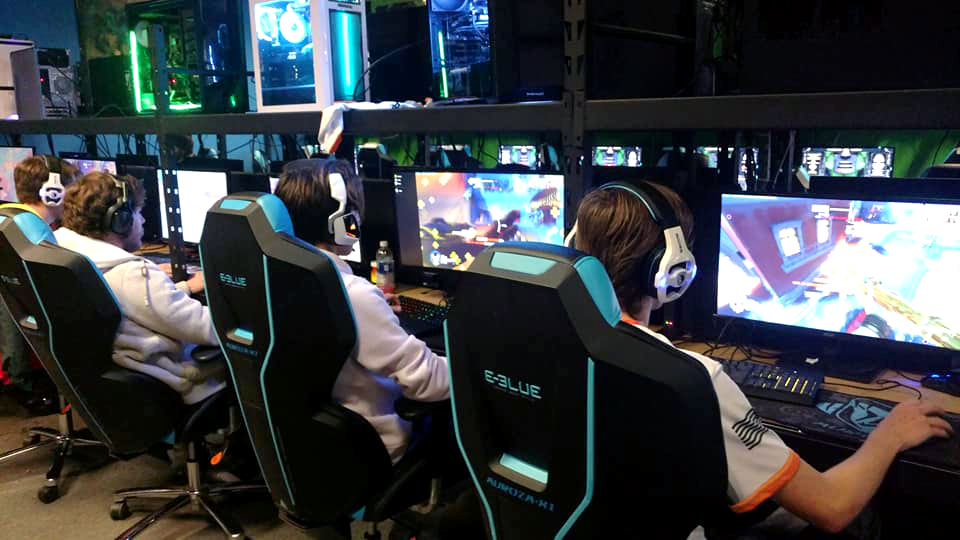
The Gamerz Funk (Taylorsvile, UT)
Waypoint Cafe owner Gino Gigante says LAN cafes have been making their big comeback over the last four years. “As esports started to generate more income, more people started realising that there needs to be a spot for it,” said Gigante, who wore a Dota 2 tournament T-shirt when we met. “The LAN cafe evolved from being a place where people do their work to a place they go for pleasure — to play games after work and cut loose before going home,” Gigante said.
On a busy January Saturday, dozens of patrons crowded the cafe to watch New York’s Overwatch team compete in the Overwatch League Finals.
Gigante, who is 27, didn’t patronise LAN cafes growing up. To game with friends, he’d hook up a handful of computers at home and load up Doom. Last year, his buddy who works at a board game cafe suggested that Gigante, a former game reviewer who was helping with his family’s real estate company, take the board game cafe business model and apply it to online competitive games. Last year, he purchased 30 $US1100 ($1409) PCs for $US700 ($897) each.
It’s not a LAN centre; it’s an esports arena, he says — although, I was hard-pressed to find anyone except business owners calling it that. Gigante’s cafe is casting a wide net by catering to serious game-players who follow esports and aspire to play at a high skill level as well as to cafe-goers who enjoy the general ambience of gaming.
LAN centres are a stable, widespread business across developed Asian countries like South Korea and Japan. In the US, that hasn’t been the case as most people owned flip phones and used dial-up. Lots of gamers have ’00s war stories about Friday night Counter-Strike Source tournaments at greasy cyber cafes, but as high-end tech reached market saturation, these stores were forced to close or modernise.
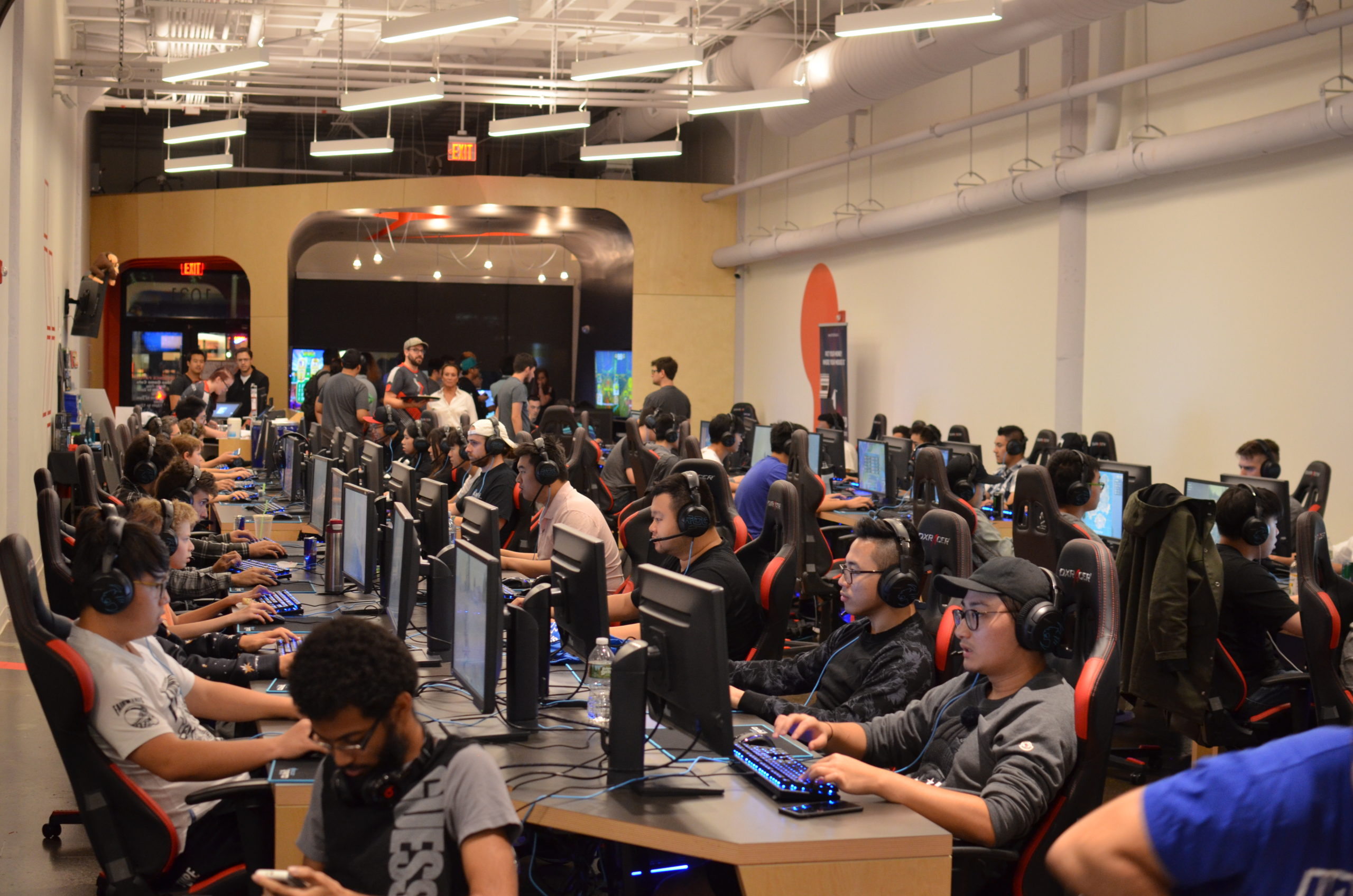
Balance Patch (Boston, MA)
Michael Winger owns Taylorsville, Utah’s very 2007-sounding The Gamerz Funk. In the mid-aughts, Winger’s LAN center boasted dingy white walls and basically no decor. “We just threw up counter space and computers and let people go at it,” he said. “We had nice leather chairs in the mid-2000s. Now, they want the esports chairs. It’s about the mechanical keyboards. Before, we got away with cheap membrane keyboards. I’ve got to spend more money on computers, on chairs and peripherals. No one’s gonna pay to play on a 60 Hz monitor.”
Winger says the whole experience of the LAN center has changed. It’s not a necessity anymore. Everybody has laptops and phones with internet. LAN centres are a luxury and a social hub, a cheaper place to socialise than a bar. “It’s really switching from a need basis to an experience,” Winger told me, citing his esports events and Overwatch meet-ups. Although his customers on average spend less time at The Gamerz Funk, he said, they’re coming back with more people. A lot of the time, their home computers can run top-of-the-line games; Winger’s says that The Gamerz Funk, at its core, is “going for the social gaming aspect.”
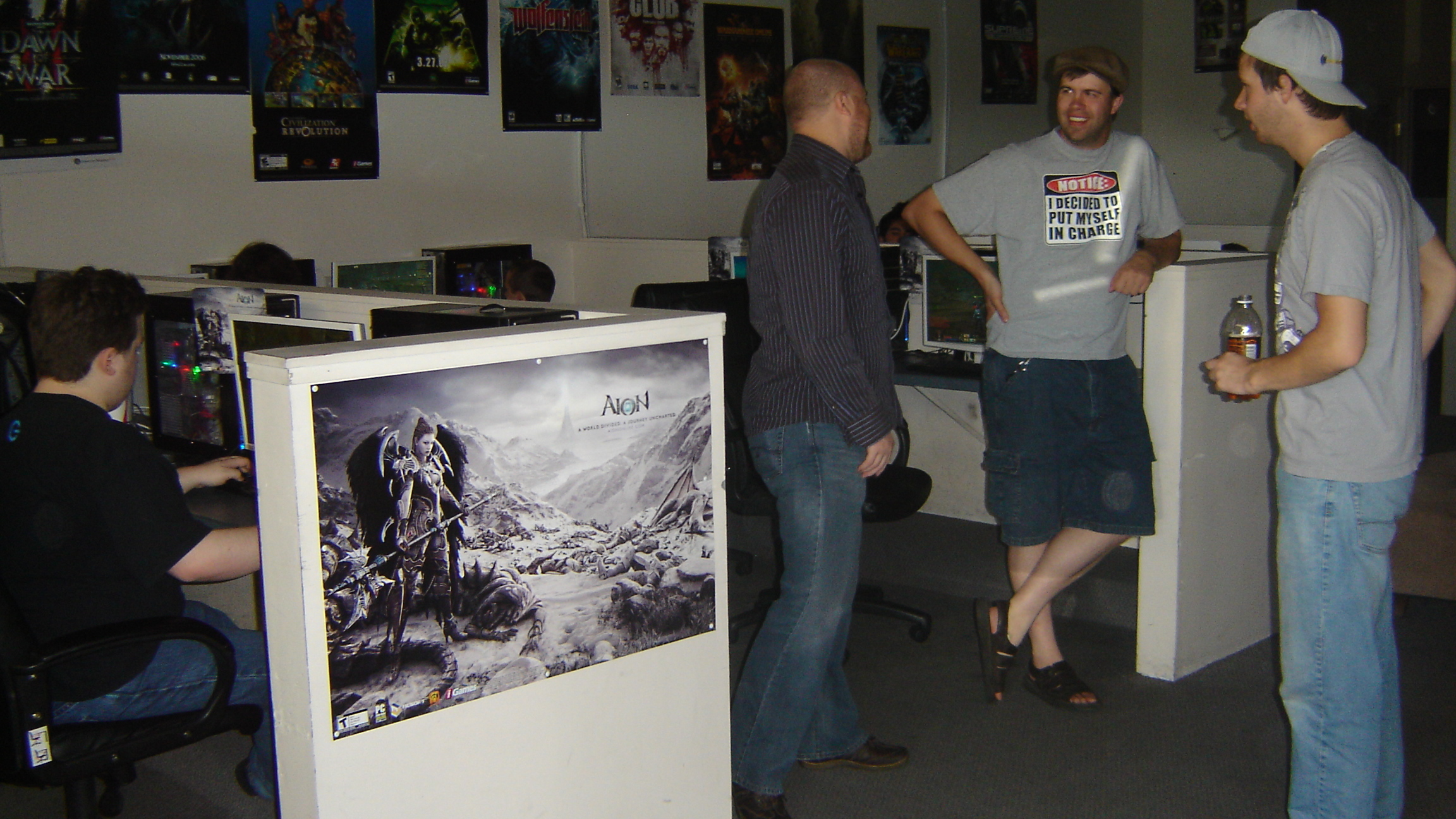
The Gamerz Funk (Taylorsville, UT) circa mid-2000s.
At these cafes, patrons pay anywhere from $US3 ($4) to $US8 ($10) an hour to play games like Overwatch, PlayerUnknown’s Battlegrounds and Dota 2 on their own accounts. It’s the same model as a cyber cafe, but now, there are perks. With friends, I frequented a modern LAN center in Northern Virginia called Cave, which opened in 2015 and suits its name — dark, hip, studded with glowing lights.
Cave’s high-backed, conspicuous gaming chairs initially made me giggle, but settling into one, I melted. On the monitor, I could push a button and order a Monster energy drink, a bag of Skittles, a Hot Pocket — whatever — that an employee would deliver to me. I could also order more time on the PCs, which are available 24/7/52. This combination of factors once led to an ill-advised and stomach-achey Overwatch binge late one Christmas evening.
Cave, Waypoint and hundreds of other LAN centres globally rely on brand new, still-in-beta LAN centre software called ggLeap. The people behind it say they have got more than 367 centres on board. The program is a Windows shell software that pulls a list of games from computers’ storage, and to play, customers just click on a game’s official art and log into their own account.
After their time’s up, the client kicks them off. Zack Johnson, its creator, has owned a LAN centre in Indiana for 14 years where he ran Halo and Counter-Strike tournaments against other LAN centres in the mid 2000s. “Five, six, seven years ago, we wouldn’t have been able to do this because the tech wasn’t there,” Johnson said, citing game CDs and janky digital downloads.
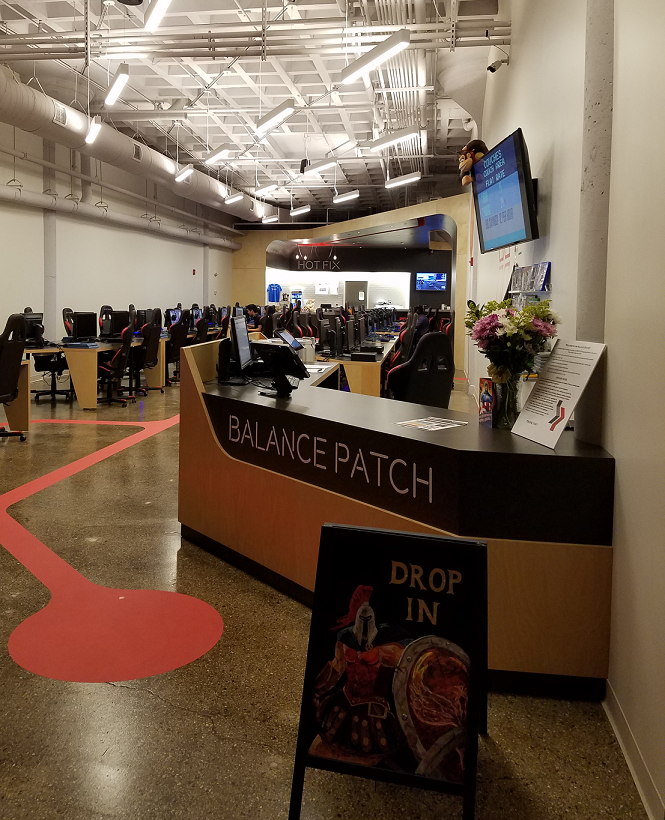
Balance Patch (Boston, MA)
Organising Johnson’s tournaments was often logistically burdensome. To smooth out the lumps, Johnson started wondering whether he could help write software to operate these regional events. In 2013, his colleagues started designing software around League of Legends esports, pulling data from publisher Riot’s API to broadcast stats.
Within three months of pushing that out, over a hundred LAN centres across the world were using it, he said. Two years later, Johnson’s software — completely re-written and accommodating dozens of games — is in high demand. He says game developers are showering him with game demo keys to share with ggLeap clients across the world.
Boston’s brand new LAN cafe, Balance Patch, operates ggLeap on their 60 sleek Alienware Aurora R6 rigs. Co-founder Bryan Rasbury says it’s one of the things that’s making his LAN Center accessible to gamers and non-gamers alike. Balance Patch projects streams onto two big screens all day and, up front, serves milkshakes and sandwiches to cafe patrons. Rasbury thinks the uptick in LAN centres is because the aficionado crowd who played Counter-Strike Source in 2004’s cyber cafes has expanded to include all kinds of people.
“There’s a general category of gamers,” Rasbury told me over the phone. “Gamers are people who know about gaming. That category is growing and growing … Gaming has gotten away from the stigma of ‘You’re at home, you might be in a basement, you don’t get out.’ Gamers are very social. They’re looking for that community aspect. LAN cafes are giving them that.”
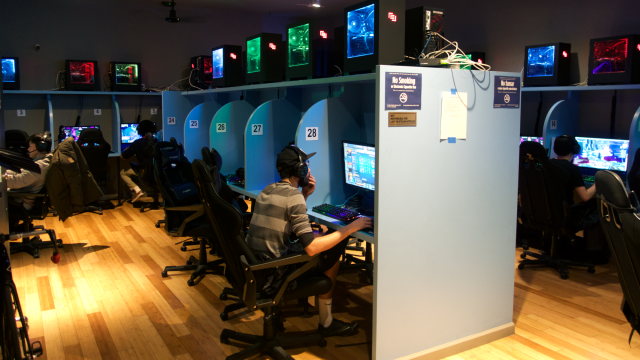
Comments
5 responses to “The LAN Cafe Is Making A Comeback”
God I miss these, back in the day my mates would be awesome and throw me a couple of bucks to play some games. Good times.
Back when WC3tft, BF2, CSS and UT2k14 were common lan games.
That was the golden age of PC games.
I miss the Cyberroom on Brisbane’s Adelaide St.
Used to be one of the biggest in the country. Stocked a bunch of then hard-to-find products like Jolt cola. Dark with multicoloured LED lighting everywhere, the place was always thumping with explosions in the booming bass of its powerful machines. They kept the machines pretty damn high-end, and they had dozens and dozens of them. The toilets had a quiet space for couch and relax that served as a kind of antechamber between the chaos of the gaming floor and the tighter-packed, ‘quiet’ netcafe section for emails and study. Very reasonable rates, comfy chairs, a huge Steam catalogue, latest games and tech, and special promos that gave you hours of gaming time for free… 24/7. God knows I spent more than a couple all-nighters catching quick naps on that couch.
I learned to spend my more troubled times in there, instead of drinking myself to death in the casino when everywhere else was closed. Somewhere to sit and grieve after funerals, staring dead-eyed into the distracting glow of… fucking whatever. Custom Neverwinter Nights servers. Natural Selection. BF1942. The first post-Bay Transformers game.
And happier times using the place as a gathering hub for games of Left4Dead with mates. You could install your own shit – I ran Warhammer Age of Reckoning on their machines because it trumped my own and the net was faster/more stable there.
Good times. I moved away for work, and when I returned, it had closed. I miss that place.
Me and a friend went to the OP Gaming Cafe one night after dinner out in the city in Melbourne to play some PubG. It was fun, but it felt a bit grubby using a mouse, keyboard, headphones that countless other random people had been using. And the general aroma of the place also made it clear to me that some people need to seriously consider their level of personal hygiene. That being said, it was good fun to be gaming with a bunch of other people in the same room all having fun, something a bit different.
i used to go to the seediest Lan Cafe in like 2005-2008 in Liverpool NSW… it was kinda grotty and dank but damn if those computers werent way better than i could afford at home and they sold energy drinks when they were still weird and cool (anyone remember bawls?)… i would get there at 5PM and game (read: Play WOW) with a group of friends till like 4-5am… and the whole night was like $20 very cheap night out.
I miss places like that.
Zen Gaming Lounge in the Melbourne CBD is pretty simple yet cool. Good prices, great staff, lots of machines and single handily keeping the LAN gaming scene alive in Melbourne.